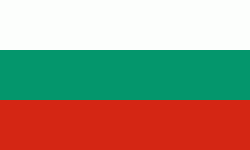Ivanovo Municipality (Obshtina Ivanovo)
The municipality covers a territory of 495.45 km² with a population of 10,339 inhabitants, as of December 2009.
The area is best known with the Rock-hewn Churches of Ivanovo which is an UNESCO World Heritage Site. Other important sights in the municipality include the medieval Bulgarian fortress of Cherven, which reached its apogee in the 13th and 14th centuries and features a well-preserved keep from the 14th century, and the Rusenski Lom Nature Park.
The population is predominantly Bulgarian (83.5%), with Turkish (9.4%), Romani (5.9%) and other minorities (1.2%, mostly Tatars in the village of Trastenik).
The main road E85 crosses the area from south to north, connecting the province centre of Ruse with the cities of Veliko Tarnovo and respectively Pleven and Sofia.
Ivanovo Municipality includes the following 13 places (towns are shown in bold):
Map - Ivanovo Municipality (Obshtina Ivanovo)
Map
Country - Bulgaria
 |
 |
| Flag of Bulgaria | |
One of the earliest societies in the lands of modern-day Bulgaria was the Neolithic Karanovo culture, which dates back to 6,500 BC. In the 6th to 3rd century BC the region was a battleground for ancient Thracians, Persians, Celts and Macedonians; stability came when the Roman Empire conquered the region in AD 45. After the Roman state splintered, tribal invasions in the region resumed. Around the 6th century, these territories were settled by the early Slavs. The Bulgars, led by Asparuh, attacked from the lands of Old Great Bulgaria and permanently invaded the Balkans in the late 7th century. They established the First Bulgarian Empire, victoriously recognised by treaty in 681 AD by the Eastern Roman Empire. It dominated most of the Balkans and significantly influenced Slavic cultures by developing the Cyrillic script. The First Bulgarian Empire lasted until the early 11th century, when Byzantine emperor Basil II conquered and dismantled it. A successful Bulgarian revolt in 1185 established a Second Bulgarian Empire, which reached its apex under Ivan Asen II (1218–1241). After numerous exhausting wars and feudal strife, the empire disintegrated and in 1396 fell under Ottoman rule for nearly five centuries.
Currency / Language
| ISO | Currency | Symbol | Significant figures |
|---|---|---|---|
| BGN | Bulgarian lev | лв | 2 |
| ISO | Language |
|---|---|
| BG | Bulgarian language |
| TR | Turkish language |















